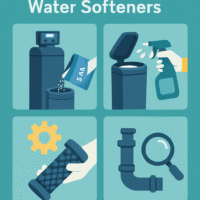Best Way To Dechlorinate Tap Water
The Ultimate Guide: Best Ways to Dechlorinate Tap Water
Chlorine is commonly used as a disinfectant in municipal water systems to kill harmful bacteria and viruses. While this process is essential for maintaining the safety of drinking water, chlorine can render the water unpalatable and potentially harmful in other ways, especially when it comes to sensitive ecosystems and human health. This article explores the best methods for dechlorinating tap water, providing an in-depth understanding of various techniques, their effectiveness, and practical applications.
Understanding Chlorination
Overview of Chlorine in Water Treatment
Chlorination is a process employed by many water treatment facilities to eliminate pathogens that could pose health risks to consumers. When chlorine is added to water, it reacts with contaminants, leading to their inactivation. The corresponding by-products can include chlorinated organic compounds, some of which have been associated with health risks such as cancer and reproductive issues.
The Need for Dechlorination
While chlorine is effective in disinfection, some individuals and organizations advocate for the removal of chlorine from drinking water for several reasons:
-
Taste and Odor: Chlorine imparts a strong taste and smell to water that many people find unpleasant. This can deter individuals from hydrating adequately.
-
Aquarium Care: For those who maintain aquariums, chlorine can be harmful to fish and plants. Dechlorinating tap water is essential for creating a safe environment for aquatic life.
-
Hydroponics and Gardening: Chlorinated water can inhibit plant growth, affecting nutrient absorption and overall health of plants.
- Health Concerns: Some studies suggest that chlorine and its by-products may contribute to certain health problems, although the levels found in municipal water are generally considered safe for immediate human consumption.
Methods for Dechlorinating Tap Water
1. Boiling Water
How It Works
Boiling water is a simple and effective method for removing chlorine. The heat causes chlorine to evaporate, leading to the dechlorination of the water.
Steps
- Bring the water to a rolling boil.
- Keep boiling for at least 15 minutes.
- Allow the water to cool before use.
Advantages
- Simplicity: Requires minimal equipment and is feasible for any household.
- Effectiveness: Can remove most chlorine from water.
Disadvantages
- Energy-Consuming: Requires energy to heat the water, which may not be practical for large volumes.
- Taste: Boiling may not remove chloramines (a combination of chlorine and ammonia), which are common in some water systems.
2. Use of Activated Carbon Filters
How They Work
Activated carbon filters remove chlorine from water through a process called adsorption, where chlorine molecules adhere to the surface of the activated carbon.
Steps
- Purchase a point-of-use activated carbon filter or a pitcher with a built-in activated carbon element.
- Follow the manufacturer’s instructions for installation and replacement of cartridges.
- Use the filtered water as required.
Advantages
- Convenience: A more user-friendly solution for ongoing dechlorination, especially for drinking and cooking water.
- Multi-Purpose: Effective at removing other contaminants, improving water taste and odor.
Disadvantages
- Regular Maintenance: Filters need to be replaced periodically to maintain effectiveness.
- Cost: While relatively affordable, the ongoing cost of replacing filters can add up.
3. Chemical Dechlorination
How It Works
Chemical dechlorination involves adding chemicals that react with chlorine or chloramines to neutralize them. Common chemicals used include sodium thiosulfate, ascorbic acid (vitamin C), or potassium metabisulfite.
Steps
- Select a dechlorinating agent.
- Follow the manufacturer’s guidelines for dosage based on the volume of water.
- Stir the solution to ensure thorough mixing before use.
Advantages
- Rapid Dechlorination: This method acts quickly, making it ideal for situations requiring immediate results (e.g., filling an aquarium).
- Effective Against Chloramines: Works well for both chlorine and chloramine removal.
Disadvantages
- Need for Precise Measurements: Incorrect dosage can lead to ineffective treatment or possibly the introduction of new chemicals into the water.
- Cost: Purchasing chemical agents can add up, especially for high volumes of water.
4. Using Water Conditioners
How They Work
Water conditioners, often marketed for aquarium use, also utilize chemicals to neutralize chlorine and other harmful substances in water.
Steps
- Purchase a water conditioner suitable for dechlorination.
- Follow the instructions on the bottle for proper dosage according to your water volume.
- Mix and allow the water to sit for a specified time if required.
Advantages
- Tailored for Aquatic Life: Specifically designed to make municipal water safe for fish and other aquatic organisms.
- Convenience: Generally readily available and easy to use.
Disadvantages
- Costly for Large Volumes: Like chemical dechlorinators, the cost can add up with larger quantities of water.
- Limited Use: Primarily targeted for aquarium applications rather than general household use.
5. Using Reverse Osmosis
How It Works
Reverse osmosis (RO) units utilize a semi-permeable membrane to filter out contaminants, including chlorine, from water. The construction of the membrane prevents larger molecules and ions from passing through.
Steps
- Install a reverse osmosis system according to the manufacturer’s instructions (usually under the sink or in a designated location).
- Allow the system to produce treated water, which is collected in a holding tank.
- Use the water as needed, particularly for drinking and cooking.
Advantages
- Comprehensive Filtration: Removes not only chlorine but also many other contaminants including heavy metals and nitrates.
- Taste Improvement: Provides excellent taste and odor purification.
Disadvantages
- High Initial Cost: Installation can be expensive compared to other methods.
- Waste Water: Reverse osmosis systems produce a certain amount of wastewater during the filtration process.
6. Solar Dechlorination
How It Works
Solar dechlorination leverages UV rays from the sun to catalyze the evaporation of chlorine from water. This method is particularly useful in warm climates.
Steps
- Fill clear containers with tap water.
- Place them in direct sunlight for 6–8 hours.
- Use the water as needed, preferably for non-consumption purposes.
Advantages
- Eco-Friendly: Relies solely on natural energy without introducing additional chemicals.
- Cost-Effective: Requires minimal financial outlay—only containers and sunlight.
Disadvantages
- Time-Consuming: Requires significant time for chlorine removal. Not practical for immediate needs.
- Effectiveness: Less effective in removing chloramines.
7. Using Ultraviolet (UV) Light
How It Works
UV treatment utilizes ultraviolet light to kill bacteria, viruses, and deactivate chlorine and chloramines in water. This method is increasingly popular in both household and commercial applications.
Steps
- Install a UV water purification system as per manufacturer’s guidelines.
- Ensure proper maintenance of the UV lamp.
- Collect treated water from the system for use.
Advantages
- High Efficacy: Effectively handles a variety of pathogens and chemicals.
- Speed: Provides on-demand water treatment.
Disadvantages
- Initial Setup Cost: Installation can be costly and may require professional assistance.
- Electricity Requirement: Functions need electricity, which could be an issue during power outages.
Considerations for Dechlorination
Before selecting a dechlorination method, you should consider several factors:
Type of Chlorine Present
- Chlorine vs. Chloramines: Depending on your municipal water supply, it’s important to identify whether chlorine or chloramines are used as a disinfectant, as certain methods are more effective against one or the other.
Volume of Water
- For small quantities (e.g., filling a pitcher), boiling or using activated carbon may suffice. For larger volumes (like filling an aquarium), more permanent solutions like RO systems or UV filters could be justified.
Purpose of Water Use
- Consider the intended use of the treated water, whether for drinking, gardening, or fish tanks. Different uses may necessitate different treatment methods to ensure safety and effectiveness.
Conclusion
Dechlorinating tap water is not only essential for enhancing taste and health but also for protecting sensitive ecosystems, especially in home aquariums and gardens. With various methods at your disposal—from simple boiling to sophisticated reverse osmosis—you can choose the best approach depending on your specific requirements and circumstances.
Whatever your choice, it’s advisable to conduct periodic tests of your water to ensure that your dechlorination efforts are effective and that you’re providing the best quality water for your needs. Whether you’re looking for an inexpensive solution or searching for high-quality purification systems, the right method is available for every situation.
In a world where clean water is paramount, understanding and implementing effective dechlorination practices will ensure that you and your loved ones remain not only healthy but hydrated, enjoying clean, delicious water at home or in any setting you choose.



